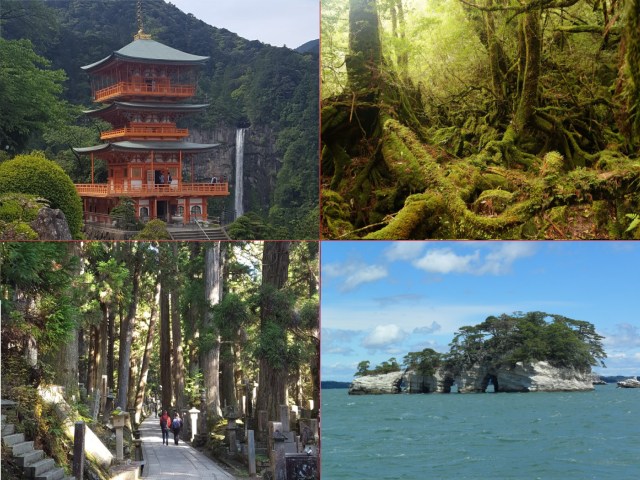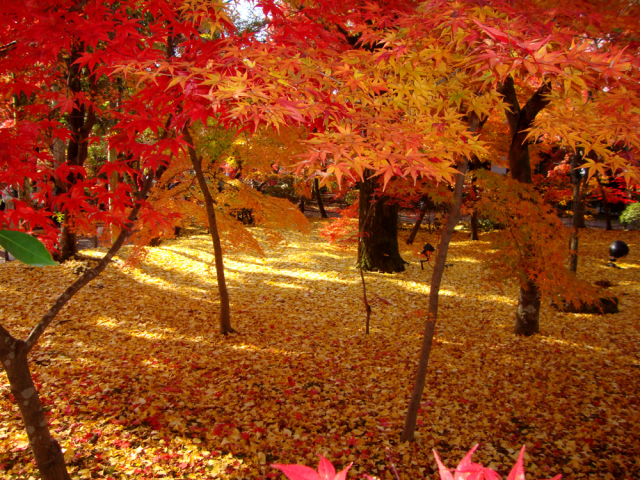From elegant gardens to stoic shrines and museums of fine art, Tokyo is full of places to stimulate the mind, soothe the soul, and please the senses.
shrines (Page 8)
The tree is said to curse those who draw near, but thankfully divine protection is available nearby.
It’s all in the name of Japanese culture and tradition.
One shinto shrine is making news around Japan for dressing their miko in a garment many had never seen before.
Anime-style outfits have become so popular they’re inspiring their own fan art.
Some of Japan’s most iconic places to see the autumn leaves are now off-limits to photographers.
After making a splash at the box office, Makoto Shinkai’s latest anime leads to something you can pour into a sake cup.
Ranking of Japan’s best fall colors will have you ready to head into the great (and red) outdoors.
With her own official Twitter account and a town in Tottori Prefecture behind her, Japan’s first ever cannabis character comes dressed as a pink-haired shrine maiden.
See what the future holds for this curious kitten who decided to dip into a box of cat-adorned fortune-telling charms.
If you’re planning to visit this Shinto shrine’s Gym, you might want to say some prayers first.
The Kyoto shrine famous for thousands of vermilion torii gates will spirit you away to a mystical world of beauty this weekend at its famous annual night-time festival.
Read More

















 Starbucks Japan releases new Frappuccino and latte for Valentine’s Day
Starbucks Japan releases new Frappuccino and latte for Valentine’s Day What’s inside Starbucks Japan’s fukubukuro lucky bag for 2026?
What’s inside Starbucks Japan’s fukubukuro lucky bag for 2026? 10 times to avoid traveling in Japan in 2026
10 times to avoid traveling in Japan in 2026 How lucky are the themed retro video game lucky bags from this shop in the Tokyo boonies?
How lucky are the themed retro video game lucky bags from this shop in the Tokyo boonies? Ramen restaurant’s English menu prices are nearly double its Japanese ones, denies discriminating
Ramen restaurant’s English menu prices are nearly double its Japanese ones, denies discriminating Visiting the Kikyoya Shingen Mochi theme park takes some planning–but it’s a stop worth making!
Visiting the Kikyoya Shingen Mochi theme park takes some planning–but it’s a stop worth making! Say hello to Japan’s new stationmaster cat!【Video】
Say hello to Japan’s new stationmaster cat!【Video】 Four Shinto shrines to pray for love at in Japan to start the New Year
Four Shinto shrines to pray for love at in Japan to start the New Year Bandai to release super-mega-retro-robot made up of Doraemon and friends
Bandai to release super-mega-retro-robot made up of Doraemon and friends South Korean design company turns subway maps into beautiful artwork you can hang on your wall
South Korean design company turns subway maps into beautiful artwork you can hang on your wall Japanese beef bowl chain Sukiya’s 2026 Smile Box lucky bag basically pays for itself
Japanese beef bowl chain Sukiya’s 2026 Smile Box lucky bag basically pays for itself Our 52-year-old pole dancing reporter shares his tips for achieving your New Year’s exercise goal
Our 52-year-old pole dancing reporter shares his tips for achieving your New Year’s exercise goal Top Japanese cosplayer Enako returns to Comiket after 6 years, creates mayhem with admirers
Top Japanese cosplayer Enako returns to Comiket after 6 years, creates mayhem with admirers Cup Noodle tries an authentic Jiro-style ramen, but something’s not quite right
Cup Noodle tries an authentic Jiro-style ramen, but something’s not quite right Hayao Miyazaki says Happy New Year to Studio Ghibli fans with new art for Year of the Horse
Hayao Miyazaki says Happy New Year to Studio Ghibli fans with new art for Year of the Horse Starbucks Japan ready to get Year of the Horse started with adorable drinkware and plushies【Pics】
Starbucks Japan ready to get Year of the Horse started with adorable drinkware and plushies【Pics】 Umamusume anime girl plushie recalled for having parts she absolutely should not have【Pics】
Umamusume anime girl plushie recalled for having parts she absolutely should not have【Pics】 We ate sushi made from Japan’s most expensive tuna ever【Taste test】
We ate sushi made from Japan’s most expensive tuna ever【Taste test】 7-Eleven Japan starts new temporary luggage storage service in over 300 branches
7-Eleven Japan starts new temporary luggage storage service in over 300 branches Disillusionment at Tsukiji’s tourist-target prices led us to a great ramen restaurant in Tokyo
Disillusionment at Tsukiji’s tourist-target prices led us to a great ramen restaurant in Tokyo Starbucks teams up with 166-year-old Kyoto doll maker for Year of the Horse decorations【Photos】
Starbucks teams up with 166-year-old Kyoto doll maker for Year of the Horse decorations【Photos】 Tokyo’s Tsukiji sushi neighborhood asks tour groups to stay away for the rest of the month
Tokyo’s Tsukiji sushi neighborhood asks tour groups to stay away for the rest of the month Japan may add Japanese language proficiency, lifestyle classes to permanent foreign resident requirements
Japan may add Japanese language proficiency, lifestyle classes to permanent foreign resident requirements Lacquerware supplier to emperor of Japan and Pokémon team up for new tableware
Lacquerware supplier to emperor of Japan and Pokémon team up for new tableware Starbucks Japan releases new zodiac chilled cup drink for 2026
Starbucks Japan releases new zodiac chilled cup drink for 2026 Tokyo considering law requiring more trash cans following litter increase in heavily touristed area
Tokyo considering law requiring more trash cans following litter increase in heavily touristed area Survey asks foreign tourists what bothered them in Japan, more than half gave same answer
Survey asks foreign tourists what bothered them in Japan, more than half gave same answer Japan’s human washing machines will go on sale to general public, demos to be held in Tokyo
Japan’s human washing machines will go on sale to general public, demos to be held in Tokyo We deeply regret going into this tunnel on our walk in the mountains of Japan
We deeply regret going into this tunnel on our walk in the mountains of Japan Studio Ghibli releases Kodama forest spirits from Princess Mononoke to light up your home
Studio Ghibli releases Kodama forest spirits from Princess Mononoke to light up your home Major Japanese hotel chain says reservations via overseas booking sites may not be valid
Major Japanese hotel chain says reservations via overseas booking sites may not be valid Put sesame oil in your coffee? Japanese maker says it’s the best way to start your day【Taste test】
Put sesame oil in your coffee? Japanese maker says it’s the best way to start your day【Taste test】 No more using real katana for tourism activities, Japan’s National Police Agency says
No more using real katana for tourism activities, Japan’s National Police Agency says Starbucks Japan reveals new sakura drinkware collection, inspired by evening cherry blossoms
Starbucks Japan reveals new sakura drinkware collection, inspired by evening cherry blossoms Updated cherry blossom forecast shows extra-long sakura season for Japan this year
Updated cherry blossom forecast shows extra-long sakura season for Japan this year Human washing machine pods coming to Japanese hotels【Photos】
Human washing machine pods coming to Japanese hotels【Photos】 Visiting the Kikyoya Shingen Mochi theme park takes some planning–but it’s a stop worth making!
Visiting the Kikyoya Shingen Mochi theme park takes some planning–but it’s a stop worth making! Say hello to Japan’s new stationmaster cat!【Video】
Say hello to Japan’s new stationmaster cat!【Video】 Four Shinto shrines to pray for love at in Japan to start the New Year
Four Shinto shrines to pray for love at in Japan to start the New Year Bandai to release super-mega-retro-robot made up of Doraemon and friends
Bandai to release super-mega-retro-robot made up of Doraemon and friends South Korean design company turns subway maps into beautiful artwork you can hang on your wall
South Korean design company turns subway maps into beautiful artwork you can hang on your wall Dragon Quest Burgers and Slime drinks are coming to McDonald’s Japan【Video】
Dragon Quest Burgers and Slime drinks are coming to McDonald’s Japan【Video】 Private booths are coming to Japan’s Shinkansen bullet trains even sooner than we’d thought【Video】
Private booths are coming to Japan’s Shinkansen bullet trains even sooner than we’d thought【Video】 Rakuten randomly offers 58 New Year’s osechi feasts in Japan, but did we get a star or a dud?
Rakuten randomly offers 58 New Year’s osechi feasts in Japan, but did we get a star or a dud? Here it is: The finalized map for Super Nintendo World at Universal Studios Japan (and its food)
Here it is: The finalized map for Super Nintendo World at Universal Studios Japan (and its food) Bamboo trees vandalized near Kyoto’s Fushimi Inari shrine, foreign graffiti prevalent
Bamboo trees vandalized near Kyoto’s Fushimi Inari shrine, foreign graffiti prevalent We cosy up to Starbucks Japan’s sexy new Frappuccino for Valentine’s Day
We cosy up to Starbucks Japan’s sexy new Frappuccino for Valentine’s Day All-you-can drink deal in Japan puts the self-serve drinks machine right on your table
All-you-can drink deal in Japan puts the self-serve drinks machine right on your table 11 different ways to say “father” in Japanese
11 different ways to say “father” in Japanese